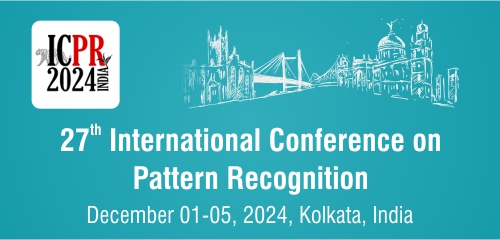| Call for Second-Round new Paper Submission |
The International Conference on Pattern Recognition (ICPR) is the flagship conference of the International Association of Pattern Recognition and the premier conference in Pattern Recognition, covering Computer Vision, Machine learning, Image, Speech, Sensor pattern processing etc. ICPR-2024 is the 27th event of the series which will be held at Kolkata, India during December 1-5, 2024. ICPR will also celebrate its 50th year during ICPR-2024. This conference provides a great opportunity to nurture new ideas and collaborations for students, academics, and industry researchers. ICPR-2024 will cover the following six tracks:
- Artificial Intelligence, Pattern Recognition and Machine Learning
- Computer and Robot Vision
- Image, Speech, Signal and Video Processing
- Biometrics and Human Computer Interaction
- Document Analysis and Recognition
- Biomedical Imaging and Bioinformatics
The main conference has several highlights, including keynotes by top experts, invited talks by academic and industry professionals, oral paper presentation, poster paper presentation, etc. ICPR-2024 will also have many Workshops and Tutorials.
Because of several requests as well as to enrich the technical program, ICPR-2024 is planning to have second-round submissions like other popular conferences. Prospective authors are invited to submit their papers in the second-round submissions of ICPR-2024.
Important deadlines for ICPR-2024 2nd round submissions are as follows:
Second-round new Paper submission deadline: July 8, 2024
Second-round new Paper Acceptance notification: August 20, 2024
Camera-ready submission for the second round new paper: August 31, 2024
| Second-round new Paper Submission and Review |
| New papers for second-round should be submitted using this link: https://cmt3.research.microsoft.com/2ndICPR2024/. ICPR-2024 will follow a single-blind review process. Authors can include their names and affiliations in the manuscript. Also, the authors can submit their arXiv papers in ICPR-2024. |
|
Paper Format and Length Springer LNCS format with maximum 15 pages (including references) during paper submission. There is no minimum page limit. To take care of reviewers' comments, one more page is allowed (without any charge) during camera ready submission. Moreover, authors may purchase up to 2 extra pages (50 USD per page). Extra page charges must be paid at the time of registration. ICPR-2024 proceeding will be published in Springer LNCS, and LNCS paper formatting instructions and templates for ICPR-2024 are available here DOC and Latex |
|
Participation and Paper Presentation Mode ICPR 2024 will be held in hybrid mode. However the organizer of ICPR encouraged the participants to attend the conference physically. Each accepted paper should have at least one author registration at the regular rate (member or non-member). A regular rate registration can cover a maximum of two papers (it may be two main conference papers, or one main conference paper and one workshop paper). Student registration only allows attending the conference and presenting papers, does not allow including paper in the proceedings. If an author cannot attend physically after registration, a proxy can be entrusted to present the paper physically. Otherwise, the authors can present it online. All no-show (which are not presented either online or offline)papers will be excluded from the conference proceedings. Registration for virtual attention only allows listening to the talks and accessing the papers, and does not allow presenting papers virtually. |
|
Supplementary materials: By the submission deadline, the authors may optionally submit additional material that was ready at the time of paper submission but could not be included due to constraints of format or space. The authors should refer to the contents of the supplementary material appropriately in the paper. Reviewers will be encouraged to look at it, but are not obligated to do so. Supplementary material may include videos, proofs, additional figures or tables, more detailed analysis of experiments presented in the paper. There is no page limit for the supplementary materials but only one file with maximum file size of 50 MB is allowed for submission. We encourage (if possible) authors to upload their code as part of their supplementary material in order to help reviewers assess the quality of the work. |




